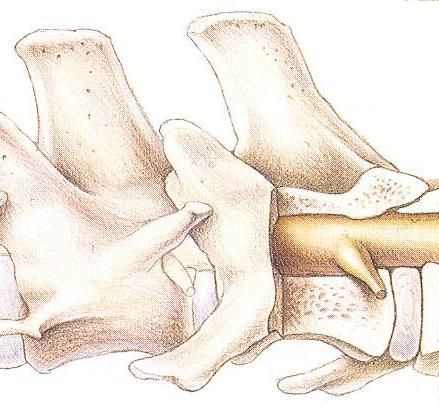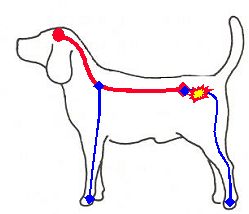FORAMINAL STENOSIS (DLSS)
Unclassified longstanding Lameness of the Hindlegs with a History of frustrating Diagnostic Workup
Foraminal Stenosis is a complex syndrome, that is why some speak about Nerve Root Compression Syndrome. It is related to the hindlegs and causes back pain. Furthermore, these patients feel nerve root pain in relation to movement (often jumping), like a filamentary pain sensation from the thigh down to the paw. We know this pain pattern from humans who can also suffer from this disease.
The medical history includes mostly „lameness since month“. The orthopedical workup is mostly completed but without diagnosis. Usually prescribed pain medication (NSAIDs) are no longer effective, Cortisone is helpful only for some weeks.

Anatomy
Each nerve root of the spinal cord runs through a corresponding neuroforamen (little bony recesses between the vertebral bodies), to form the peripheral nerves, which guarantee limb innervation.
On pressure and traction these nerve roots react with induction of pain sensation (Nerve root pain).
Typical Appearance of the Disease
Dogs and cats with Foraminal Stenosis are neurological cases, but their lameness is often confused with an orthopedic problem (movement related pain without paralysis).
The patients often express a short yelp while jumping upwards. Limb lifting can be painful, because the ischiadic nerve can be stretched with this maneuver. Work exaggerates, rest relieves this pain sensation. Lumbosacral stretching can be painful and intensify the lameness.
The stance of the affected leg is less firm, advanced cases show less muscle tone in the limb or even signs of muscle loss (you can feel like „empty trousers“). Both-sided stenoses often shift weight from one side to another. 20% of the patients have additionally orthopedic hip- and kneeproblems.
Urinary and fecal incontinence are known comorbidities of foraminal stenosis, which can disappear after effective treatment.
A predisposition for foraminal stenosis can be seen in 2-11 year old hunting dogs or German Shepherds, Labrador Retrievers, Boxers, Great Danes, Hovawarths, Briards and Border Collies.
Diagnostics of Foraminal Stenosis
X-ray signs are very discrete and the nerve does not show up in plain radiographs. That is why this syndrome is often undiagnosed for quite a while.
Because the nerve root is rarely completely compressed, so that its motoric function is still preserved, we won´t see typical paralysis, which we would expect in neurological disease.
Effective diagnostic workup has to include a thorough clinical and neurological examination, Radiography, Elektrodiagnostics and MRI – this generates also critical data for surgery. Existing comorbidities have to be assessed before treatment of Foraminal Stenosis!
Spontaneous improvement is not to be expected in Foraminal Stenosis!
Without neurosurgery disease progression is predictable!
Surgery (Foraminotomy)
During Foraminotomy the affected Neuroforamen is dilated by surgical preparation in a matter that the nerve root postoperatively runs free from pressure or adhesions along the widened nerve root canal.
Postsurgical care is important and includes physiotherapy. During 3-6 months compressive nerve damage is repaired by regeneration. Permanent pain relief and full functional recovery is reached in 80% of the cases.
Physiotherapy is important postoperative supportive Care
Efficient physiotherapy accelerates and improves regenerative processes in peripheral nerves. It helps to treat spastic and painful muscles and to attenuate postoperative or posture deficit related disorders of the affected limb, which in part might have been apparent presurgically due to the neurocompressive syndrome.
The Physiotherapy Programme includes:
Weeks 1-2: passive training
Weeks 3-6: muscle training, leish walks only
Weeks 7-12: trot walks, water treadmill, terrain walks
Months 4-5: condition exercises
Working dogs are allowed the hurdle jump only after 6 months. Beforehand professional warming up is essential.

